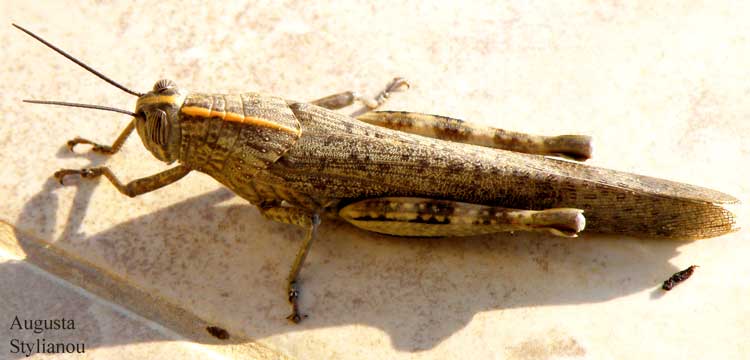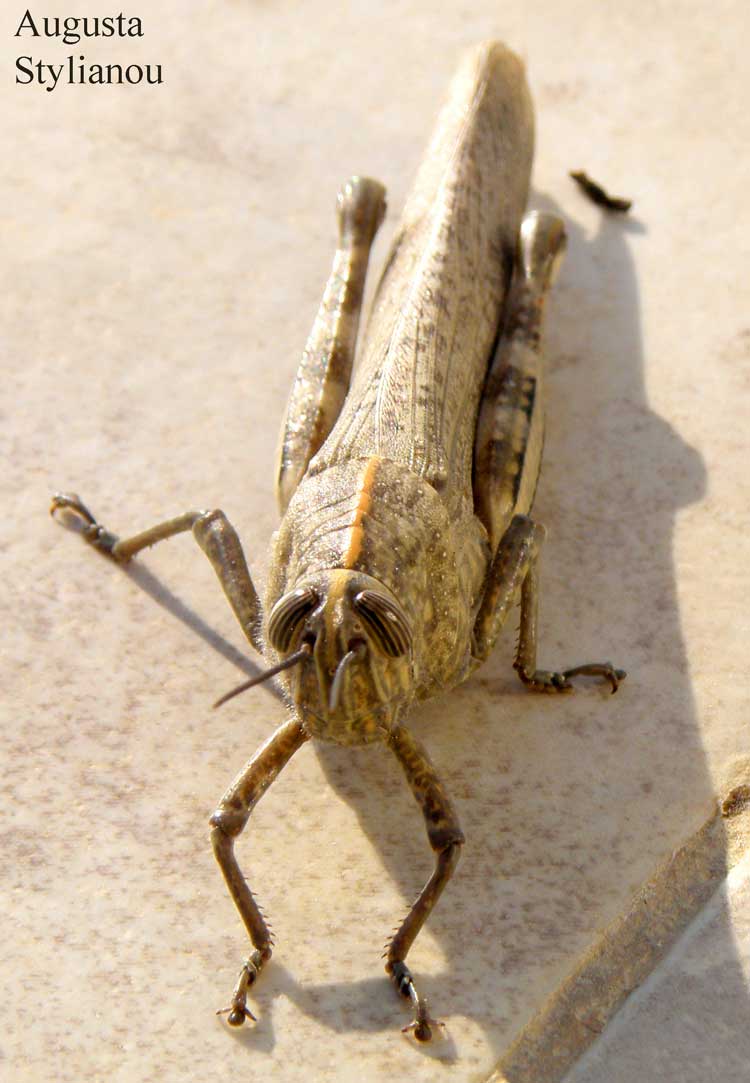
Anacridium aegyptium, Germasogeia, Cyprus, Photo: Augusta Stylianou Artist
Superregnum: Eukaryota
Cladus: Unikonta
Cladus: Opisthokonta
Cladus: Holozoa
Regnum: Animalia
Subregnum: Eumetazoa
Cladus: Bilateria
Cladus: Nephrozoa
Cladus: Protostomia
Cladus: Ecdysozoa
Cladus: Panarthropoda
Phylum: Arthropoda
Subphylum: Hexapoda
Classis: Insecta
Cladus: Dicondylia
Subclassis: Pterygota
Ordo: Orthoptera
Subordo: Caelifera
Infraordo: Acrididea
Superfamilia: Acridoidea
Familia: Acrididae
Subfamilia: Cyrtacanthacridinae
Tribus: Cyrtacanthacridini
Genus: Anacridium
Species: Anacridium aegyptium
Name
Anacridium aegyptium (Linnaeus, 1764)
Vernacular names
Deutsch: Ägyptische Wanderheuschrecke
français: Criquet égyptien
Anacridium aegyptium, the Egyptian grasshopper or Egyptian locust, is a species of insect belonging to the subfamily Cyrtacanthacridinae.
Subspecies
Anacridium aegyptium var. rubrispinum Bei-Bienko, 1948 - Anacridium rubrispinum Bei-Bienko, 1948

Anacridium aegyptium, Photo: Augusta Stylianou Artist
Distribution
This quite common species is present in most of Europe, the Afrotropical realm, eastern Palearctic realm, the Near East, and North Africa,[2] and recently seen in Cape Town, South Africa.
Habitat
These grasshoppers inhabit trees and shrubs, scrub land, maquis, and orchards in warm and bright environments, at an elevation from sea level to 1,500 m.[3][4]
Description
Close-up of Anacridium aegyptium
Anacridium aegyptium is one of the largest European grasshoppers. The adult males grow up to 30–56 mm (1.2–2.2 in) long, while females reach 46–70 mm (1.8–2.8 in) in length. Their bodies are usually gray, brown, or olive-coloured, and their antennae are relatively short and robust. The tibiae of the hind legs are blue, while the femora are orange. The hind femora have characteristic dark marks. They are easily identifiable also by the characteristic eyes with vertical black and white stripes. Their pronota show a dorsal orange stripe and several white small spots. The wings are clear with dark marks.[5][4]
Biology
This species is a folivore, essentially feeding on leaves of various plants.[4] It is a solitary species, not harmful to crops. Adults can mainly be encountered in August and September, but they are active throughout the year.[3][4] After mating, these grasshoppers overwinter as adults. Spawning occurs in spring just under the soil surface[4] and the nymphs appear in April.[3] These grasshoppers undergo several molts.[4] The nymphs have the appearance of the adults, their color varies from yellow to bright green and ocher and the wings are absent or small, as they are gradually developed after each molting.[4]
References
BioLib
Fauna europaea
Linnea (in Italian)
Wildside Holidays
Ostravska Univerzita (in Czech)
Linneus, 1764 : Museum S.R.M. Ludovicae Ulricae reginae Svecorum, Gothorum, Vandalorum,… In quo animalia raroria, exotica, imprimis Insecta et Conchilia describuntur et determinantur Prodromi instar editum.
Retrieved from "http://en.wikipedia.org/"
All text is available under the terms of the GNU Free Documentation License

